-
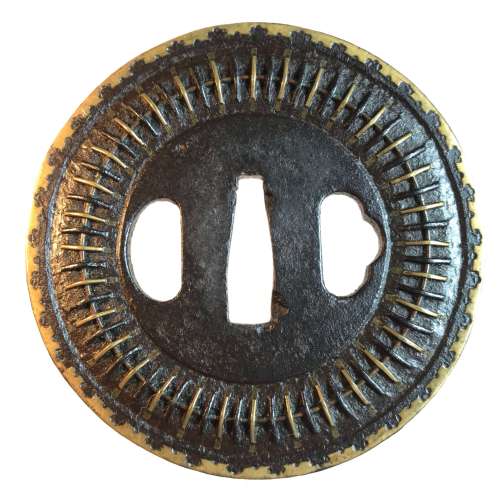 Mukade-zōgan tsuba with two types of wires. Iron, inlaid with brass and iron wire fastened to the surface with metal staples (mukade-zōgan); Brass inlay around the rim. Design is thought to resemble a centipede. "Centipede-like inlay (mukade zogan) of alternating iron and brass staples produce an appearance that was particularly favored by Takeda Shingen (1521-1573), one of the most powerful warlords of his time. The centipede is sacred to Bishamon (God of War) and especially propitious for a warrior. Shingen type, 16th century.” [The Peabody Museum collection of Japanese sword guards with selected pieces of sword furniture, by John D. Hamilton. Photographs by Mark Sexton. Salem, MA, 1975.] Height: 85.8 mm; Width 86.2 mm; Thickness at seppa-dai: 4.3 mm. Weight 177.6 g. Early Edo, 17th century. http://varshavskycollection.com/shingen-tsuba/
Mukade-zōgan tsuba with two types of wires. Iron, inlaid with brass and iron wire fastened to the surface with metal staples (mukade-zōgan); Brass inlay around the rim. Design is thought to resemble a centipede. "Centipede-like inlay (mukade zogan) of alternating iron and brass staples produce an appearance that was particularly favored by Takeda Shingen (1521-1573), one of the most powerful warlords of his time. The centipede is sacred to Bishamon (God of War) and especially propitious for a warrior. Shingen type, 16th century.” [The Peabody Museum collection of Japanese sword guards with selected pieces of sword furniture, by John D. Hamilton. Photographs by Mark Sexton. Salem, MA, 1975.] Height: 85.8 mm; Width 86.2 mm; Thickness at seppa-dai: 4.3 mm. Weight 177.6 g. Early Edo, 17th century. http://varshavskycollection.com/shingen-tsuba/ -
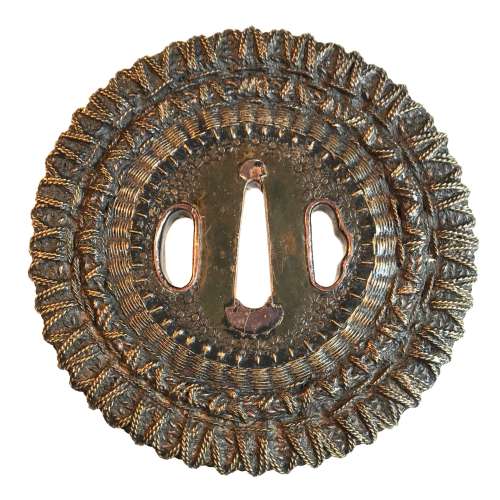 Shingen school (or style) tsuba of round form with an iron core of spoked-wheel shape, with its centre covered with a copper plate decorated with star-shaped punch marks. From this copper plate outward, the body is formed by brass and copper wire (flat and twisted) in a weave pattern. Both hitsu-ana are outlined in brass with a raised rim. Copper sekigane. Unsigned. Edo period, 18th century. SOLD Height: 98.0 mm, Width: 97.4 mm, Thickness at seppa-dai: 6.0 mm. Weight: 290 g. NBTHK certificate №436696: 'Hozon' attestation. Citing "JAPANESE SWORD-MOUNTS IN THE COLLECTIONS OF FIELD MUSEUM" by Helen C. Gunsaulus, Assistant Curator of Japanese Ethnology. 61 plates. Berthold Laufer, Curator of Anthropology. Field Museum of Natural History, Publication 216, Anthropological Series, Volume XVI; Chicago, 1923; p.45: "An unusual group of tsuba popular in the late sixteenth century and afterwards is made up of those guards known as Shingen tsuba, a name which was derived from a sixteenth-century warrior, Takeda Shingen (Takeda Harunobu, 1521-73), who is said to have preferred this style of guard, as it combined strength and lightness. Under the category of "Shingen", four different types abd generally listed, though a fifth appears in the drawings in the Boston Catalogue of Okabe Kakuya "Japanese Sword Guards" (p. 21). It is square, that form which is said to have been used in Ashikaga days for scaling walls, the sword having been set up as a step. [...] The following descriptions include, however, the Shingen tsuba usually met with.
Shingen school (or style) tsuba of round form with an iron core of spoked-wheel shape, with its centre covered with a copper plate decorated with star-shaped punch marks. From this copper plate outward, the body is formed by brass and copper wire (flat and twisted) in a weave pattern. Both hitsu-ana are outlined in brass with a raised rim. Copper sekigane. Unsigned. Edo period, 18th century. SOLD Height: 98.0 mm, Width: 97.4 mm, Thickness at seppa-dai: 6.0 mm. Weight: 290 g. NBTHK certificate №436696: 'Hozon' attestation. Citing "JAPANESE SWORD-MOUNTS IN THE COLLECTIONS OF FIELD MUSEUM" by Helen C. Gunsaulus, Assistant Curator of Japanese Ethnology. 61 plates. Berthold Laufer, Curator of Anthropology. Field Museum of Natural History, Publication 216, Anthropological Series, Volume XVI; Chicago, 1923; p.45: "An unusual group of tsuba popular in the late sixteenth century and afterwards is made up of those guards known as Shingen tsuba, a name which was derived from a sixteenth-century warrior, Takeda Shingen (Takeda Harunobu, 1521-73), who is said to have preferred this style of guard, as it combined strength and lightness. Under the category of "Shingen", four different types abd generally listed, though a fifth appears in the drawings in the Boston Catalogue of Okabe Kakuya "Japanese Sword Guards" (p. 21). It is square, that form which is said to have been used in Ashikaga days for scaling walls, the sword having been set up as a step. [...] The following descriptions include, however, the Shingen tsuba usually met with.- So-called Mukade ("centipede") tsuba are made of iron in which a centepede is inlaid in brass or copper wire. Mukade tsuba of Myōchin and Umetada warkmanship have been found with the inscription, "Made to the taste of Takeda Shingen".
- There are those of solid iron, with need centers of brass, to the edges of which is affixed a weaving of brass and copper wires which is bound to the foundation disk by a rim, usually decorated simply.
- Another type is of solid iron, bored at intervals and laced with braided or twisted wires of copper and brass.
- The fourth type is a chrysanthemoid form, chiselled in open work and laced or woven tightly with copper and brass wire."
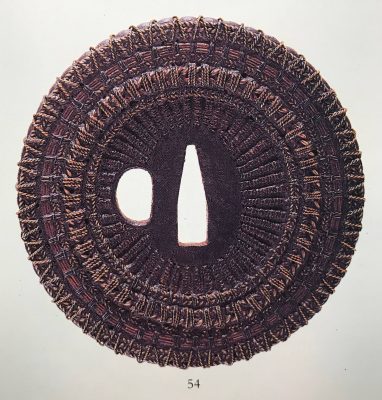
Compton Collection, Part II, p.p. 26-27, №54.
-
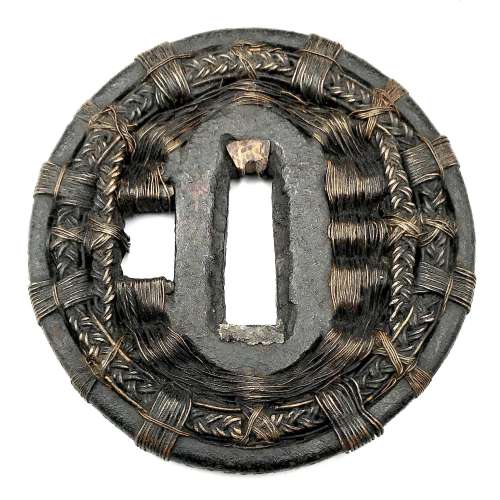 Shingen school tsuba with woven wire pattern. Iron core, woven brass wire. Height: 72.5 mm; Width 69.8 mm; Thickness at seppa-dai: 4.0 mm. Weight 88.8 g. Late Muromachi, 16th century. SOLD http://varshavskycollection.com/shingen-tsuba/
Shingen school tsuba with woven wire pattern. Iron core, woven brass wire. Height: 72.5 mm; Width 69.8 mm; Thickness at seppa-dai: 4.0 mm. Weight 88.8 g. Late Muromachi, 16th century. SOLD http://varshavskycollection.com/shingen-tsuba/ -
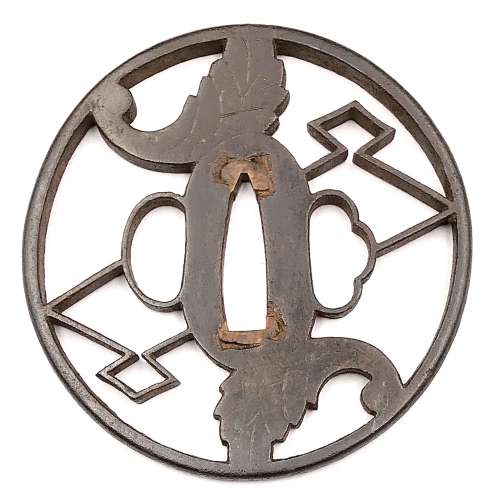 Iron tsuba of round form with design of ginger and double diamonds (myoga-ni-nigaibishi) in openwork (sukashi), details carved in kebori technique. Slightly rounded square rim. Copper sekigane. Shoami school. Early Edo period: Late 17th century (Kanbun/Enppo era). Height: 80.1 mm. Width: 79.8 mm. Rim thickness: 5.0 mm. Center thickness: 4.7 mm. Provenance: Sasano Masayuki Collection, № 110.
Iron tsuba of round form with design of ginger and double diamonds (myoga-ni-nigaibishi) in openwork (sukashi), details carved in kebori technique. Slightly rounded square rim. Copper sekigane. Shoami school. Early Edo period: Late 17th century (Kanbun/Enppo era). Height: 80.1 mm. Width: 79.8 mm. Rim thickness: 5.0 mm. Center thickness: 4.7 mm. Provenance: Sasano Masayuki Collection, № 110. -
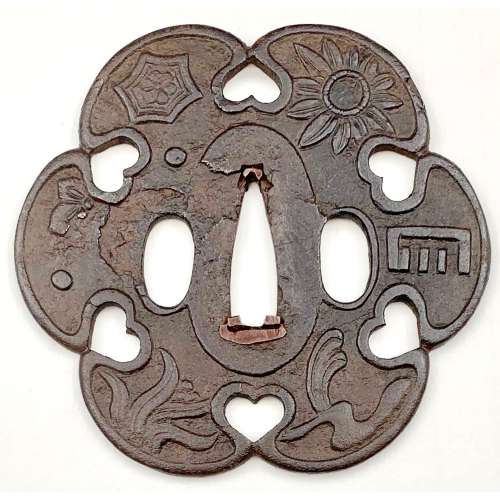 Iron tsuba of six-lobed (mutsu-mokkō-gata) form, with six wild boar's eye shape (inome) openings (sukashi). Ryo-Hitsu and the entire perimeter of tsuba have typical for this school raised rim; raised seppa dai. Lobes are decorated in low relief carving (sukidashi-bori). On the obverse: chrysanthemum, Genji mon, waves and rocks, grasses and star, bellflower, star and flower in tortoiseshell (kikko). On the reverse: Stars and different flowers, and flying geese. The plate is damaged to the left of nakago-ana and around the left hitsu-ana. Kamakura-bori school. Late Muromachi period (1514-1573). Diameter: 89 mm; Thickness at seppa-dai: 4.0 mm; Weight: 108.8 g [large]. There is a similar tsuba in this collection, TSU-0345.2018, but with a different motif and much smaller: diameter 74.3 mm, thickness at seppa-dai: 3.2 mm, weight: 62.8 g.Another look-a-like tsuba can be found at the Compton Collection, part II, pp. 14-15, №17, though his tsuba is more massive (80 x 84 x 4 mm).
Iron tsuba of six-lobed (mutsu-mokkō-gata) form, with six wild boar's eye shape (inome) openings (sukashi). Ryo-Hitsu and the entire perimeter of tsuba have typical for this school raised rim; raised seppa dai. Lobes are decorated in low relief carving (sukidashi-bori). On the obverse: chrysanthemum, Genji mon, waves and rocks, grasses and star, bellflower, star and flower in tortoiseshell (kikko). On the reverse: Stars and different flowers, and flying geese. The plate is damaged to the left of nakago-ana and around the left hitsu-ana. Kamakura-bori school. Late Muromachi period (1514-1573). Diameter: 89 mm; Thickness at seppa-dai: 4.0 mm; Weight: 108.8 g [large]. There is a similar tsuba in this collection, TSU-0345.2018, but with a different motif and much smaller: diameter 74.3 mm, thickness at seppa-dai: 3.2 mm, weight: 62.8 g.Another look-a-like tsuba can be found at the Compton Collection, part II, pp. 14-15, №17, though his tsuba is more massive (80 x 84 x 4 mm).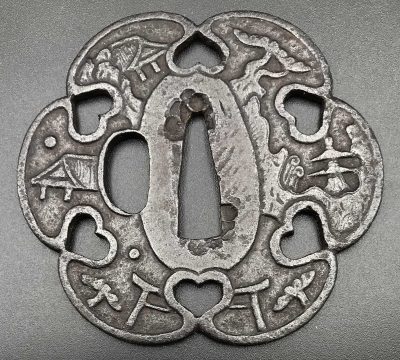
Varshavsky Collection: TSU-0345.2018
This tsuba, TSU-0401.2019, is the biggest of all three (another mine and the one from Campton Collection). The presence of a flower in a tortoiseshell symbol (crest or mon) on this tsuba alludes to Izumo Shrine. The overall piece, with symbols of grasses, waves, flowers, incense, stars, and flying geese, is full of autumnal connotations.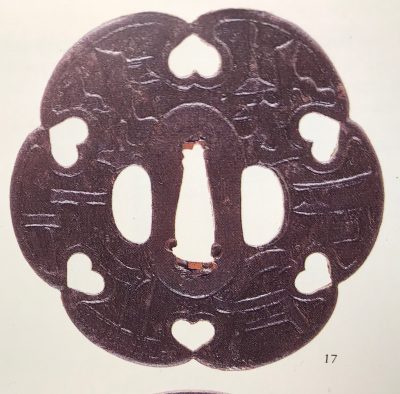
Compton Collection, part II, pp. 14-15, №17: Kamakura-bori tsuba, ca. 1450.
-
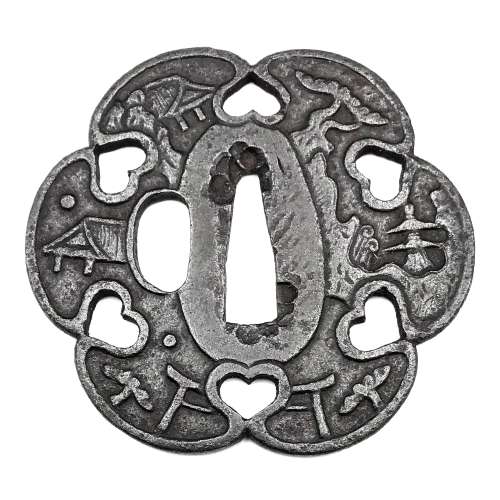 Iron tsuba of six-lobed (mutsu-mokkō-gata) form, with six wild boar's eye shape (inome) openings (sukashi). Hitsu-ana and the entire perimeter of tsuba have typical for this school raised rim. Lobes are decorated with landscape motifs in low relief carving (sukidashi-bori). On the obverse: A hut under a full moon, Shinto shrine gates (torii) with pines and a full moon, rocks, a large pine tree, and a temple (pagoda) surrounded by rocks and waves. On the reverse: waves, fishing boat, wild gees in flight under full moon, maple, hexagon (tortoiseshell, kikko) with a dot inside and a dot outside (inclusion/exclusion symbol), and chrysanthemum (the last two may be family crests, mon). Kamakura-bori school. Late Muromachi period (1514-1573). Height: 64.2 mm, width: 74.3 mm, Thickness at seppa-dai: 3.2 mm, at rim 2.6 mm. Weight: 62.8 g (light). NBTHK old green certificate №561: Tokubetsu Kicho - "Extraordinary Work". A look-a-like tsuba can be found at the Compton Collection, part II, pp. 14-15, №17, though his tsuba is more massive (80 x 84 x 4 mm).NBTHK paper says that the motif is Hakkei (八景), i.e. "Eight Views," so several interpretations are possible (the original Chinese ones, Omi Hakkei, etc.). However, most likely it is the 'Eight views of Omi' (近江八景 - 'Omi Hakkei'). Why the artist selected a 6-lobed form for depicting 8 views remains unclear, and thus we are in our right to raise the question whether the motif is indeed Hakkei. The term Omi hakkei (eight views of Omi) refers to painting or print sets which illustrate life on the shores of Lake Biwa in Omi (now Shiga Prefecture). The model for such paintings came from China, where, from the eleventh century onward, painters had produced eight views of the Hsiao and Hsiang lake areas of Hunan Province. The themes, which follow the original Chinese models, are: geese descending to land, returning fishing boats, clearing rain, a snow-covered evening landscape, the autumn moon, night rain, a temple bell at evening, and the glow of sunset. Japanese artists have also used the eight-theme approach for other parts of country - including cities - and applied it to subject matter other than landscapes. [Merrily Baird. Symbols of Japan. Thematic motifs in art and design. Rizzoli international publications, Inc., 2001, page 308-9]. Japan Encyclopedia by Louis Frédéric also mentions Omi Hakkei as "Eight landscapes of Omi", and states that this theme was often cited in poetry after 1500. It is likely that the tsuba in focus is designed under the influence of the theme popularity in the 16th century. The theme was effectively exploited by prominent ukiyo-e artists Suzuki Harunobu and Utagawa Hiroshige in the 18th and 19th century, respectively. These are the eight scenes of the theme (see Wikipedia):
Iron tsuba of six-lobed (mutsu-mokkō-gata) form, with six wild boar's eye shape (inome) openings (sukashi). Hitsu-ana and the entire perimeter of tsuba have typical for this school raised rim. Lobes are decorated with landscape motifs in low relief carving (sukidashi-bori). On the obverse: A hut under a full moon, Shinto shrine gates (torii) with pines and a full moon, rocks, a large pine tree, and a temple (pagoda) surrounded by rocks and waves. On the reverse: waves, fishing boat, wild gees in flight under full moon, maple, hexagon (tortoiseshell, kikko) with a dot inside and a dot outside (inclusion/exclusion symbol), and chrysanthemum (the last two may be family crests, mon). Kamakura-bori school. Late Muromachi period (1514-1573). Height: 64.2 mm, width: 74.3 mm, Thickness at seppa-dai: 3.2 mm, at rim 2.6 mm. Weight: 62.8 g (light). NBTHK old green certificate №561: Tokubetsu Kicho - "Extraordinary Work". A look-a-like tsuba can be found at the Compton Collection, part II, pp. 14-15, №17, though his tsuba is more massive (80 x 84 x 4 mm).NBTHK paper says that the motif is Hakkei (八景), i.e. "Eight Views," so several interpretations are possible (the original Chinese ones, Omi Hakkei, etc.). However, most likely it is the 'Eight views of Omi' (近江八景 - 'Omi Hakkei'). Why the artist selected a 6-lobed form for depicting 8 views remains unclear, and thus we are in our right to raise the question whether the motif is indeed Hakkei. The term Omi hakkei (eight views of Omi) refers to painting or print sets which illustrate life on the shores of Lake Biwa in Omi (now Shiga Prefecture). The model for such paintings came from China, where, from the eleventh century onward, painters had produced eight views of the Hsiao and Hsiang lake areas of Hunan Province. The themes, which follow the original Chinese models, are: geese descending to land, returning fishing boats, clearing rain, a snow-covered evening landscape, the autumn moon, night rain, a temple bell at evening, and the glow of sunset. Japanese artists have also used the eight-theme approach for other parts of country - including cities - and applied it to subject matter other than landscapes. [Merrily Baird. Symbols of Japan. Thematic motifs in art and design. Rizzoli international publications, Inc., 2001, page 308-9]. Japan Encyclopedia by Louis Frédéric also mentions Omi Hakkei as "Eight landscapes of Omi", and states that this theme was often cited in poetry after 1500. It is likely that the tsuba in focus is designed under the influence of the theme popularity in the 16th century. The theme was effectively exploited by prominent ukiyo-e artists Suzuki Harunobu and Utagawa Hiroshige in the 18th and 19th century, respectively. These are the eight scenes of the theme (see Wikipedia):
Compton Collection, part II, pp. 14-15, №17: Kamakura-bori tsuba, ca. 1450.
- Returning sails at Yabase (矢橋の帰帆) - Yabase. Yabase is an old harbour on the east side of the lake. Near the Tokaido, it was used for a shortcut to Otsu by boat.
- Evening glow at Seta (勢多(瀬田)の夕照) - The Chinese Bridge at Seta. The long bridge across the Seta was used by the Tokaido. In the background the "Fuji of Omi", the Mikamiyama. It is just above 400 m, but indeed well visible.
- Autumn moon at Ishiyama (石山の秋月) - Ishiyama Temple. The Ishiyamadera was located on a hillside next to the Seta River. It got his name form the strange rocks on which it is built, partly on supporting beams. A hut at the upper end of the site allows a view of the lake, and the moon.
- Clear breeze at Awazu (粟津の晴嵐) - Awazuhara. Awazu is well known for its pine wood, Awazu-ga-hara.
- Evening bell at Miidera (三井晩鐘) - Mii-dera. Miidera temple was built in the 8th century. Its famous bell is one of the "Three bells of Japan", the other two being those at Byoodo-in, Uji and at Jingoji, Kyoto.
- Evening rain at Karasaki (唐崎の夜雨) - Karasaki Shrine. Karasaki is a small cape with a single large pine tree, a hitsu-matsu.
- Wild geese returning home at Katata (堅田の落雁) - Ukimido. Alighting geese cannot be seen always, however the little temple near Katata in the square hōkyō-style, detached from the lakeside, connected by a bridge. The first part of the name uki is the same as in Ukiyo-e, meaning floating. Midō means temple.
- Evening snow at Hira (比良の暮雪) - Hira Mountains. The Hira mountains on the west side of the lake experience the hard winter, when the winter monsoon brings much snow from the continent.
-
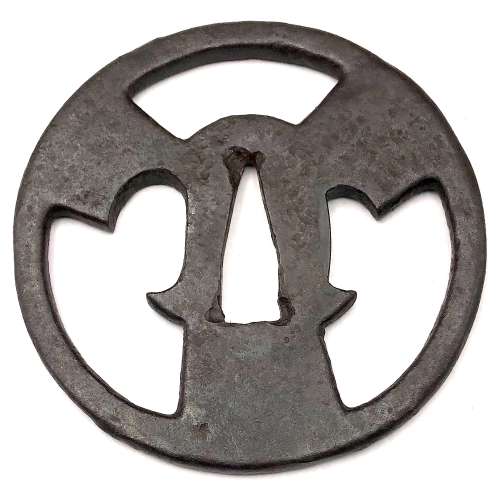 Iron tsuba of round form with three stylized folding fans motif in openwork (sukashi). Kogai-hitsu-ana with shakudō sekigane. Iron bones (tekkotsu) on the rim. Momoyama period or earlier. Possibly, Ko-Shōami school.
Iron tsuba of round form with three stylized folding fans motif in openwork (sukashi). Kogai-hitsu-ana with shakudō sekigane. Iron bones (tekkotsu) on the rim. Momoyama period or earlier. Possibly, Ko-Shōami school.Size: 76.8 x 75.7 x 4.0 mm.
[Seller alleged that the motif is "Buddhist wheel", which seems unlikely. -
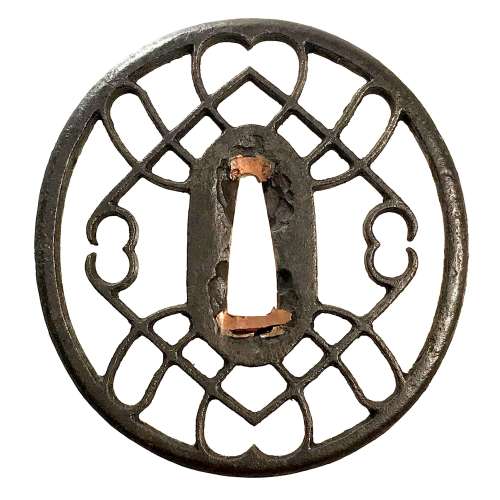 Iron tsuba of oval form with the motif of horse trappings in openwork (sukashi). Copper sekigane. Iron bones (tekkotsu) on the rim.
Iron tsuba of oval form with the motif of horse trappings in openwork (sukashi). Copper sekigane. Iron bones (tekkotsu) on the rim.Size: 80.4 x 75.8 x 5.2 mm
NBTHK Certificate №454567, allegedly saying that it is Akasaka School, Muromachi period. A look-a-like tsuba in Robert. E. Haynes Catalog #7, 1983 on page 57 under №48 is described as follows: "A masterpiece second period Owari sukashi tsuba. The plate is of beautiful color and quality almost like velvet. The design is very hard to discern, it might be the horse trappings, or even a moon. The style and type of Owari tsuba shows the great tradition of the Momoyama period and why it was the renaissance in time, as well as the arts produced, through the long history of all Japanese art. Ca. 1580. Ht. 7.7 cm, Th. (center) 5.5 mm, (edge) 5.25 to 5.75 mm."I believe we can safely attribute this tsuba to Owari School, c. 1580.
Robert. E. Haynes Catalog #7, 1983, p. 57, №48.
-
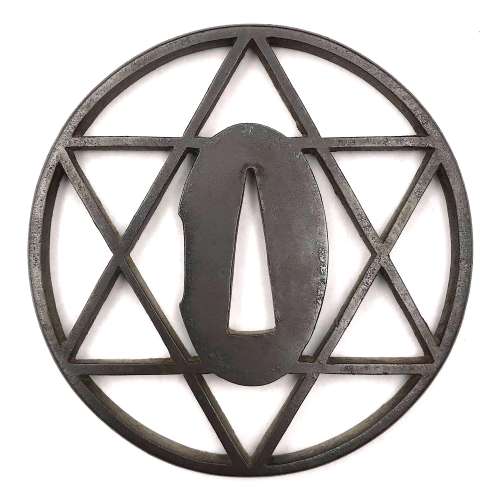 Iron tsuba of round form with two overlapping triangles (uroko) motif in openwork (sukashi). Triangle patterns usually associate with 'fish scale', mon of Hojo family (and others). Edo period or later.
Iron tsuba of round form with two overlapping triangles (uroko) motif in openwork (sukashi). Triangle patterns usually associate with 'fish scale', mon of Hojo family (and others). Edo period or later.Size: 71.4 x 70.2 x 5.2 mm.
An association with the Star of David is doubtful if not impossible. -
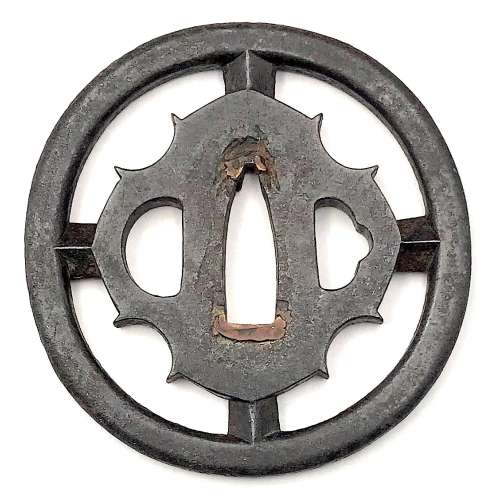 Iron tsuba of round form with slanting rays of light (shakoh) Christian motif (Jesuit's IHS symbol) in openwork (sukashi). Traditional description of this kind of design is called "tokei", or "clock gear". Edo period.
Iron tsuba of round form with slanting rays of light (shakoh) Christian motif (Jesuit's IHS symbol) in openwork (sukashi). Traditional description of this kind of design is called "tokei", or "clock gear". Edo period.Size: 77.7 x 76.1 x 6.7 mm.
For information regarding shakoh tsuba see article 'Kirishitan Ikenie Tsuba" by Fred Geyer at Kokusai Tosogu Kai; The 2nd International Convention & Exhibition, October 18-23, 2006, pp. 84-91. -
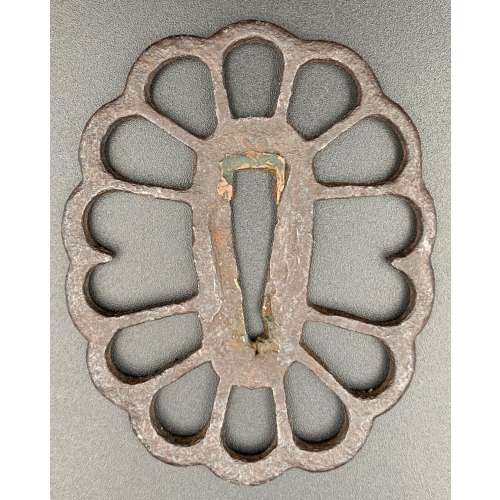
Iron tsuba with chrysanthemum design in openwork (sukashi). Copper sekigane.
Late Heian through Kamakura period (ca. 1150 - 1200's).
Size: 78.4 x 60.9 x 3.5 mm; weight: 45.7 g
Provenance: Boris Markhasin Message from Boris Markhasin (13-AUG-2019): It is a very rudimentary tachi tsuba, and the iron is old and really nothing to draw attention. However, this is a very old tsuba, and that is what makes it very special and an important study piece. This tsuba likely dates to the late Heian through Kamakura (ca. 1150 - 1200's) -- by consensus, since such examples are extremely rare, and none are mounted to my knowledge, so few direct analogues. The form is interesting for a variety of reasons. The smaller size, an oval form is associated more with 12th/13th c styles. The sukashi kiku motif is very interesting as it clearly pushes back the dating of large scale sukashi far back in time. This shouldn't be surprising, but for some reason, we (really mainly westerners) naively tend to associate sukashi with the Muromachi and younger. The two missing spokes are by consensus likely later removals to accommodate kozuka and kogai -- but this is not certain, and it could be an original styling. A key kantei point is the elongate, narrow, slightly squared seppa dai. This is a characteristic of early koshirae, which were much thinner and more delicate than the types we are used to seeing that date pretty much to the late Muromachi and later. I am always amazed when I have a chance to interrogate early koshirae at how thin they are - I want to call them fragile, but they were actually quite resilient. The walls were super thin, but the top and bottom edges were a bit thicker, providing a bit of structural support... but this is another thread topic. Of all the tsuba I have owned, this is the tsuba that has most clearly reflected the shape of the old style of saya / tsuka. -
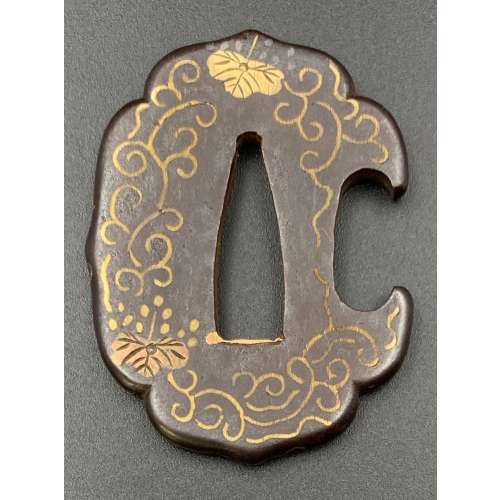
Small iron tsuba (tantō size) of aoi form with the design of paulownia leaves and blossoms in copper and brass flat inlay (hira-zōgan). Brass sekigane. Open kozuka hitsu-ana.
Early Edo period, 17th century.
Size: 53.4 x 40.7 x 4.4 mm; weight: 47.4 g
-
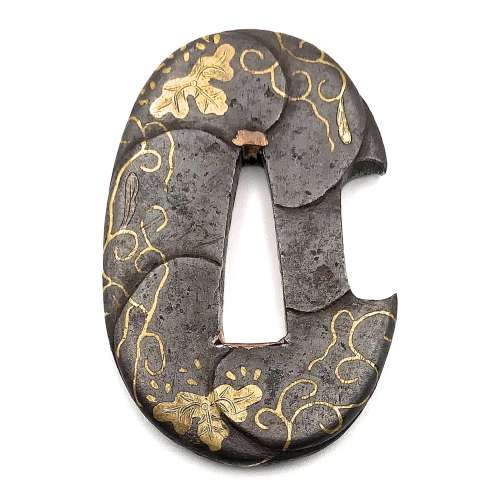
Small iron tsuba (tantō size) of oval form carved with imitation of six overlapping plates, decorated with paulownia blossoms, leaves, and tendrils in brass and copper hira-zōgan. Copper sekigane. Open kozuka hitsu-ana.
Early Edo period, 17th century.
Size: 50.5 x 34.0 x 4.9 mm.
-
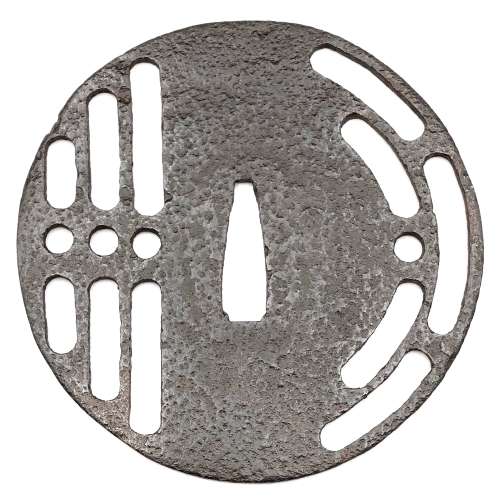 A very large and very thin iron tsuba of round form decorated with design of formalized butterfly and dragonfly in openwork (sukashi). The characteristics of the plate resemble those of Kamakura period ko-tōshō tsuba. However, the design seems too 'modern' to me, but it's hard to tell; it may be a late Muromachi or Momoyama period work. Tōshō or Ko-Tōshō school (or a Katchushi). Muromachi period. However, Boris Markhasin and Skip Holbrook insist this is a 20th-century machine-made tsuba. Dimensions: 99.6 x 100.5 x 2.1 mm. This is what Jim Gilbert says about old tsuba:
A very large and very thin iron tsuba of round form decorated with design of formalized butterfly and dragonfly in openwork (sukashi). The characteristics of the plate resemble those of Kamakura period ko-tōshō tsuba. However, the design seems too 'modern' to me, but it's hard to tell; it may be a late Muromachi or Momoyama period work. Tōshō or Ko-Tōshō school (or a Katchushi). Muromachi period. However, Boris Markhasin and Skip Holbrook insist this is a 20th-century machine-made tsuba. Dimensions: 99.6 x 100.5 x 2.1 mm. This is what Jim Gilbert says about old tsuba:"Traditionally the old iron plate tsuba are classified into Ko Tosho (old sword smith), and Ko Katchushi (old armor maker) styles. It is sometimes difficult to justify attribution of a given tsuba to the Tosho or Katchushi category. Generally guards with raised rims or relatively complex designs tend to be assigned to Katchushi. This is basically a convention we follow out of habit and convenience." [...] "In Token Kai-Shi part six, Articles by Akiyama Kyusaku, Robert Haynes comments: "…from 1300 to 1400 over 150,000 MOUNTED swords were made in Japan for export alone. This means that over four tsuba a day were made for 100 years. This would mean that at least 3000 persons were making nothing but tsuba, let alone all the other fittings needed to complete these swords. With sword smiths, fittings makers and all the other artists need to complete a sword for export, at least 10,000 sword artists were working together, in any one of these hundred years."
Another tsuba of similar design, Tōshō school, is illustrated in this collection; see TSU-0319.2015.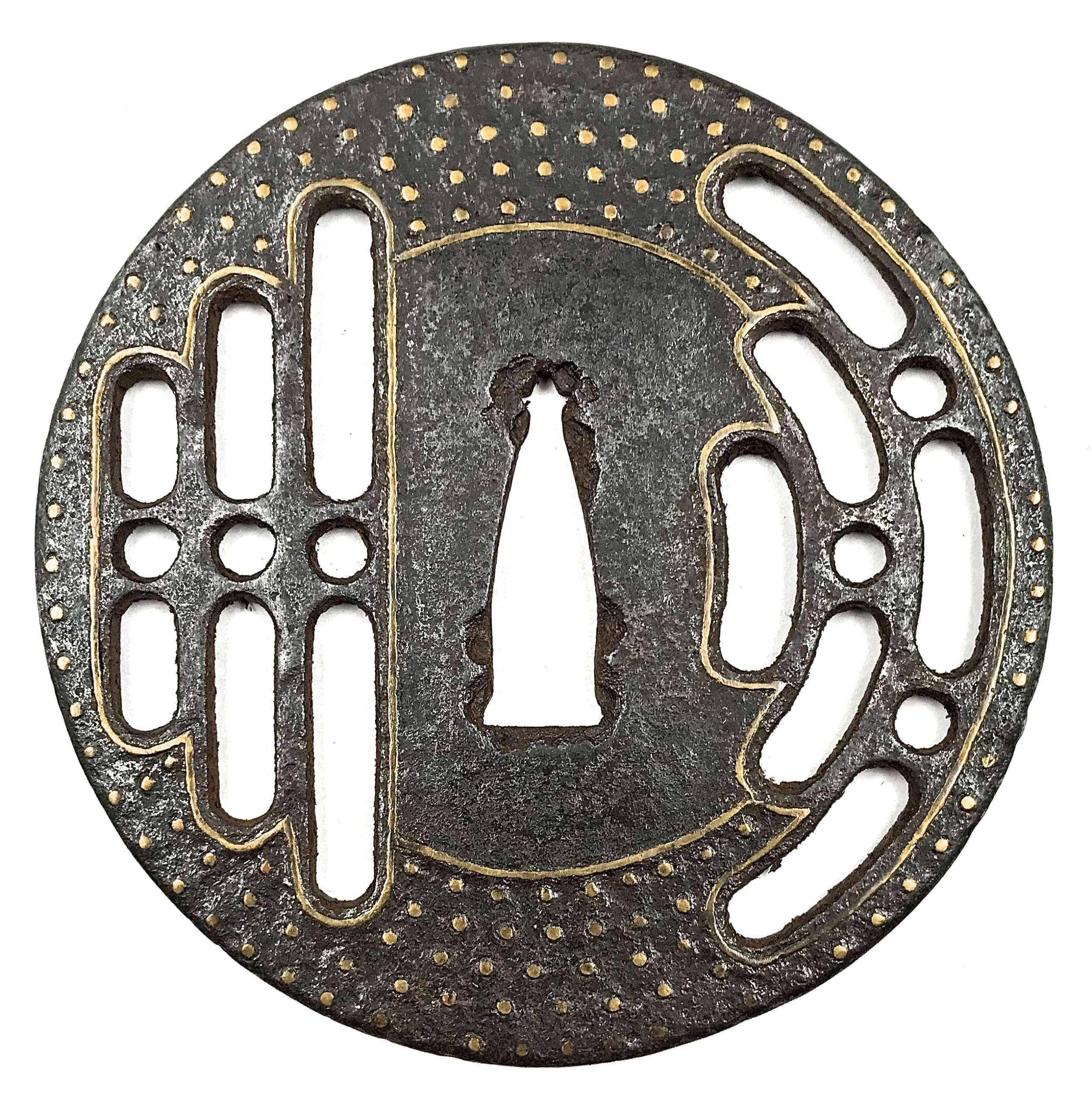 Reference to this design can be found in LIB-1359.2017 Japanese Swords and Tsuba from the Professor A. Z. Freeman and the Phyllis Sharpe Memorial collections, Sotheby's, London, Thursday 10 April 1997; p. 18-19, lot № 37: "A Kamakura-bori Tsuba, Momoyama Period. ...pierced with two large formalised butterflies..."
Reference to this design can be found in LIB-1359.2017 Japanese Swords and Tsuba from the Professor A. Z. Freeman and the Phyllis Sharpe Memorial collections, Sotheby's, London, Thursday 10 April 1997; p. 18-19, lot № 37: "A Kamakura-bori Tsuba, Momoyama Period. ...pierced with two large formalised butterflies..."
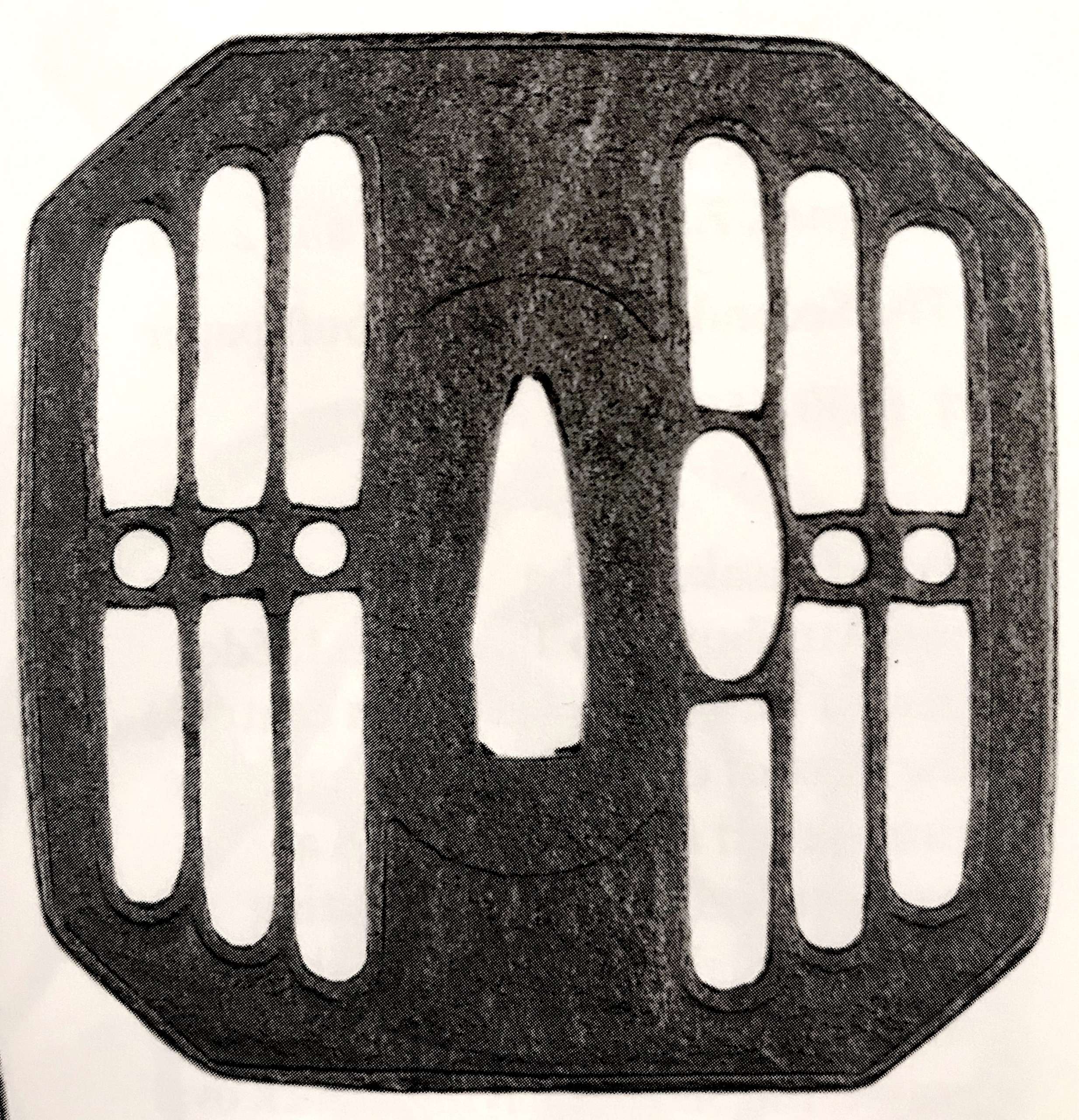
A Kamakura-bori tsuba of octagonal form, Momoyama period.
-
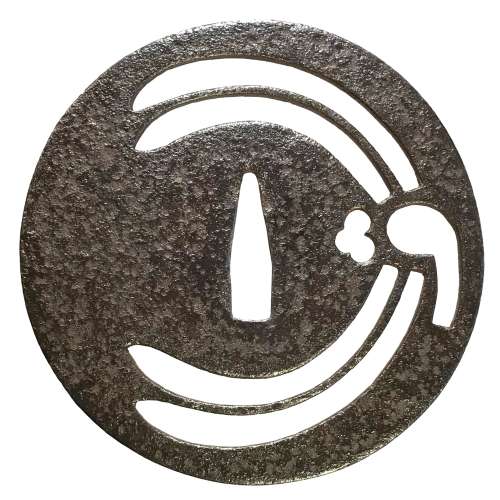 Iron tsuba of round form decorated with design of dragonfly in negative openwork (in-sukashi). It may be Ko-Tōshō (old Tōshō) or just Tōshō school, without a 'Ko'. Probably the dragonfly here is used as a family crest (mon). Muromachi period. However, Boris Markhasin and Skip Holbrook insist this is a 20th-century machine-made tsuba. Dimensions: Height: 95.0 mm. Width: 93.6 mm. Rim thickness: 2.1 mm. Center thickness: 2.3 mm. Nakago-ana: height = 30 mm, width = 7.8 mm. A dragonfly design is described by John W. Dower as following "During the period of feudal warfare, the dragonfly is reputed to have been am especially popular design applied to arrow quivers, and some warriors adopted it as a family crest. One reason for this was the insect's alternative names of katsu mushi and shogun mushi, both meaning 'victory insect'." Merrily Baird is even more talkative regarding the matter: "The dragonfly (tombo) in Japan is emblematic of martial success, as various names for the insect are homophones for words meaning "victory". The dragonfly is also auspicious because references in the Kojiki and Nihongi link it in both name and shape to the old kingdom of Yamato. This legacy has led to the use of dragonfly as an emblem on arrow quivers and as family crest. It also appears occasionally in conjunction with such imperial motifs as the chrysanthemum. Used in a context devoid of historical associations, the dragonfly is a seasonal symbol of late summer and early autumn." Dragonfly was an extremely often motif for the tsuba in all times, primarily in earlier times, before Tokugawa pacified the nation. The same motif is used on Ōnin tsuba in this collection:
Iron tsuba of round form decorated with design of dragonfly in negative openwork (in-sukashi). It may be Ko-Tōshō (old Tōshō) or just Tōshō school, without a 'Ko'. Probably the dragonfly here is used as a family crest (mon). Muromachi period. However, Boris Markhasin and Skip Holbrook insist this is a 20th-century machine-made tsuba. Dimensions: Height: 95.0 mm. Width: 93.6 mm. Rim thickness: 2.1 mm. Center thickness: 2.3 mm. Nakago-ana: height = 30 mm, width = 7.8 mm. A dragonfly design is described by John W. Dower as following "During the period of feudal warfare, the dragonfly is reputed to have been am especially popular design applied to arrow quivers, and some warriors adopted it as a family crest. One reason for this was the insect's alternative names of katsu mushi and shogun mushi, both meaning 'victory insect'." Merrily Baird is even more talkative regarding the matter: "The dragonfly (tombo) in Japan is emblematic of martial success, as various names for the insect are homophones for words meaning "victory". The dragonfly is also auspicious because references in the Kojiki and Nihongi link it in both name and shape to the old kingdom of Yamato. This legacy has led to the use of dragonfly as an emblem on arrow quivers and as family crest. It also appears occasionally in conjunction with such imperial motifs as the chrysanthemum. Used in a context devoid of historical associations, the dragonfly is a seasonal symbol of late summer and early autumn." Dragonfly was an extremely often motif for the tsuba in all times, primarily in earlier times, before Tokugawa pacified the nation. The same motif is used on Ōnin tsuba in this collection: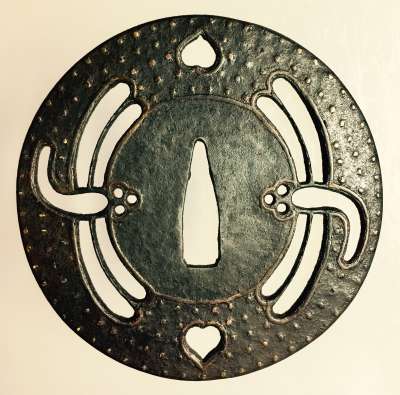
-
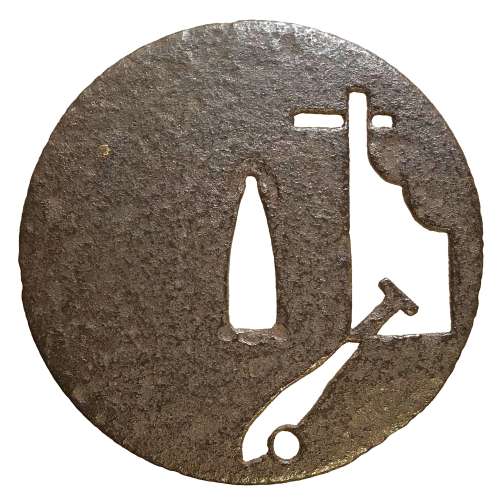 Round tsuba of iron; well forged thin plate decorated with a rudder (kaji) and an oar, or paddle (kai) with a water drop, executed in a combination of negative (in-sukashi) and positive (ji-sukashi) openwork. It may be Ko-Tōshō (old Tōshō) or just Tōshō school, without a 'Ko'. The characteristics of the plate point toward an older piece, however the combination of negative and positive silhouettes pulls the date of manufacture in an opposite direction. Muromachi period. Height: 90.0 mm. Width: 89.0 mm. Rim thickness: 2.1 mm. Center thickness: 2.3 mm. Nakago-ana: height = 29 mm, width = 8.8 mm. A rudder and an oar design is classified by John W. Dower as "Sailing vessels and gear": "Unlike many other motifs, sailing vessels and sailing gear failed to collect an interesting lore or to develop levels of meaning." Merrily Baird does not say anything about these symbols. Yuzuri Okada says: "Ships, sails, rudders, etc. also supply motive of the same class as wheels." He does not provide us with the description of the motive supplied by the wheel. The same motif is used on Ōnin tsuba in this collection:
Round tsuba of iron; well forged thin plate decorated with a rudder (kaji) and an oar, or paddle (kai) with a water drop, executed in a combination of negative (in-sukashi) and positive (ji-sukashi) openwork. It may be Ko-Tōshō (old Tōshō) or just Tōshō school, without a 'Ko'. The characteristics of the plate point toward an older piece, however the combination of negative and positive silhouettes pulls the date of manufacture in an opposite direction. Muromachi period. Height: 90.0 mm. Width: 89.0 mm. Rim thickness: 2.1 mm. Center thickness: 2.3 mm. Nakago-ana: height = 29 mm, width = 8.8 mm. A rudder and an oar design is classified by John W. Dower as "Sailing vessels and gear": "Unlike many other motifs, sailing vessels and sailing gear failed to collect an interesting lore or to develop levels of meaning." Merrily Baird does not say anything about these symbols. Yuzuri Okada says: "Ships, sails, rudders, etc. also supply motive of the same class as wheels." He does not provide us with the description of the motive supplied by the wheel. The same motif is used on Ōnin tsuba in this collection: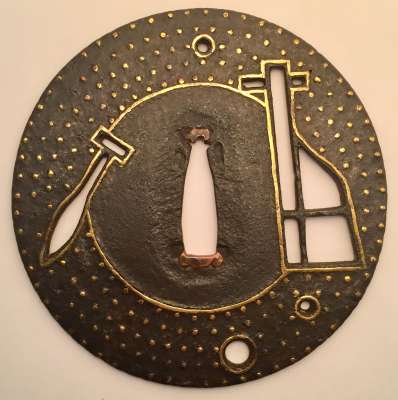
-
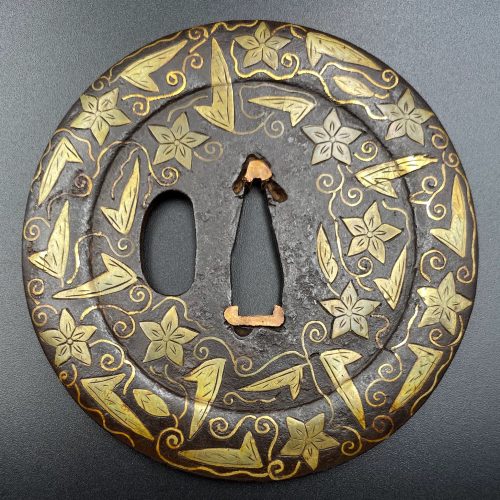 Iron tsuba of the round form (丸型, maru–gata), decorated with brass flat inlay (平象嵌, hira-zōgan) of bellflowers, leaves, and vines on both sides, inlaid brass is carved in low relief; wide rim (dote-mimi) also inlaid; the plate is pierced with hitsu-ana (probably original); nakago-ana plugged with copper sekigane. Dimensions: Height: 84.1 mm; Width: 82.0 mm; Thickness (centre): 2.8 mm; mimi is 11.8 mm wide and 4.7 mm thick. Produced at the end of the 16th century, in the Momoyama period (1674–1703).
Iron tsuba of the round form (丸型, maru–gata), decorated with brass flat inlay (平象嵌, hira-zōgan) of bellflowers, leaves, and vines on both sides, inlaid brass is carved in low relief; wide rim (dote-mimi) also inlaid; the plate is pierced with hitsu-ana (probably original); nakago-ana plugged with copper sekigane. Dimensions: Height: 84.1 mm; Width: 82.0 mm; Thickness (centre): 2.8 mm; mimi is 11.8 mm wide and 4.7 mm thick. Produced at the end of the 16th century, in the Momoyama period (1674–1703). -
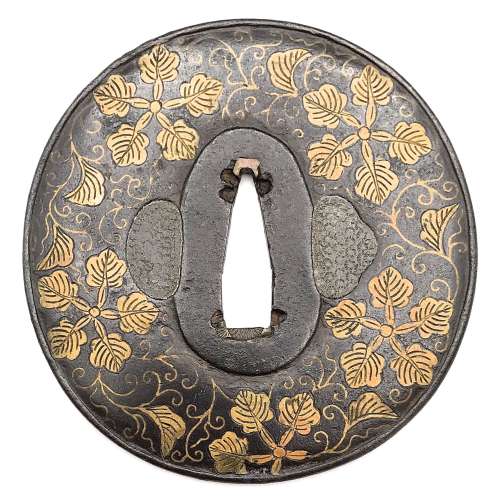 Iron tsuba of slightly elongated round form decorated with design of melon flowers, vines, and leaves in brass flat inlay (hira-zōgan) on both sides. Slightly raised rim (mimi) carved in a way to simulate ring-shaped covering (fukurin). Kozuka hitsu-ana and kogai hitsu-ana both plugged with soft metal (tim or lead). Copper sekigane. Heianjō or Kaga School. Muromachi or Momoyama period, 16th century. Iron, hira-zōgan brass inlay. Round (maru gata) form, diameter 79 mm. Size: 80.3 x 78.4 mm; thickness at seppa-dai: 3.4 mm; at the middle: 3.8 mm; before the rim: 2.4 mm, rim: 2.8 mm. Note on design: though this design resembles family crests with oak and mulberry leaves, I believe it's a melon flower [see Jeanne Allen. Designer's guide to Samurai Patterns. Chronicle Books, San Francisco, 1990, page 114, №130 "Melon Flowers":Note about the distribution of thickness (niku-oki): "this tsuba has toroid features, niku raises from the rim towards the centre but thins once more out when approaching the seppa-dai" [M. Sesko, "Handbook...", p. 48].
Iron tsuba of slightly elongated round form decorated with design of melon flowers, vines, and leaves in brass flat inlay (hira-zōgan) on both sides. Slightly raised rim (mimi) carved in a way to simulate ring-shaped covering (fukurin). Kozuka hitsu-ana and kogai hitsu-ana both plugged with soft metal (tim or lead). Copper sekigane. Heianjō or Kaga School. Muromachi or Momoyama period, 16th century. Iron, hira-zōgan brass inlay. Round (maru gata) form, diameter 79 mm. Size: 80.3 x 78.4 mm; thickness at seppa-dai: 3.4 mm; at the middle: 3.8 mm; before the rim: 2.4 mm, rim: 2.8 mm. Note on design: though this design resembles family crests with oak and mulberry leaves, I believe it's a melon flower [see Jeanne Allen. Designer's guide to Samurai Patterns. Chronicle Books, San Francisco, 1990, page 114, №130 "Melon Flowers":Note about the distribution of thickness (niku-oki): "this tsuba has toroid features, niku raises from the rim towards the centre but thins once more out when approaching the seppa-dai" [M. Sesko, "Handbook...", p. 48].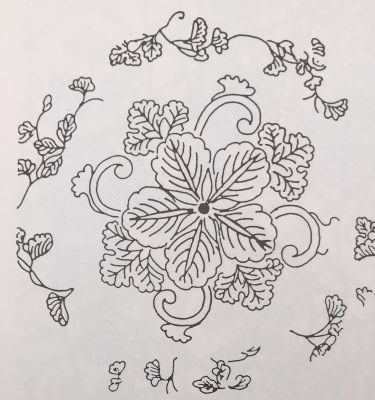
Jeanne Allen. Designer's guide to Samurai Patterns. Chronicle Books, San Francisco, 1990. Page 114, №130.


